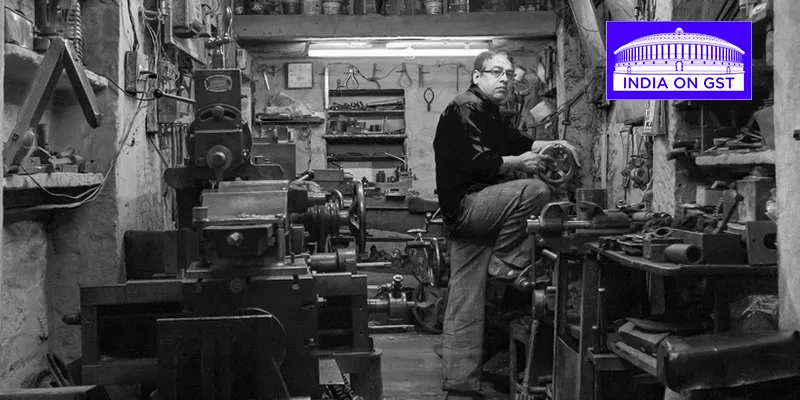Waking up to a new GST era, and its impact on small businesses in India
The implementation of the Goods and Service Tax (GST) will impact and transform India’s tax regime, making the system more transparent and more paperless, but requiring more compliance as well.

Small and Medium Enterprises (SMEs) are the primary growth drivers of the Indian economy with more than three million SMEs operating in India, contributing to almost 50 percent of the industrial output and 42 percent of India’s total exports. A leading employment-generating sector, SMEs have provided balanced development across sectors.
GST will enhance the taxpayer base by bringing more SMEs under its ambit, and will definitely pass on the burden of compliance and associated costs to them.
However, eventually GST will turn these SMEs more competitive, and level the playing field between large enterprises and them. Further, these Indian SMEs would be able to compete with foreign competitors from cheap cost centres such as China, Philippines, and Bangladesh.
Other than these, here are some more ways in which the soon-to-be-implemented tax regime is likely to affect businesses, especially startups and SMES.
Possible positive impact
Ease of starting business: Today, a business with operations across different states needs VAT registration. Different tax rules in different states only add to the complications and lead to businesses incurring a high procedural fee. GST enables a centralised registration that will make starting a business easier and the consequent expansion an added advantage for SMEs.
Market expansion: SMEs limit their customers within states as they will bear the ultimate burden of tax on interstate sales, which reduces their customer base. With implementation of GST, this will be nullified as tax credit will be transferred, irrespective of the location of the buyer and seller. This will allow startups, SMEss and MSMEs to expand their reach across borders.
Reduction of tax burden on new businesses: As per the current tax structure, businesses with an annual turnover of over Rs 5 lakh need to pay a VAT registration fee. The basic exemption limit under GST is Rs 20 lakh and Rs 10 lakh for special states, which will bring relief to a large number of small dealers and traders.
Elimination of distinction between goods and services: GST ensures that there is no ambiguity about what constitutes goods and services. This will simplify various legal proceedings related to packaged products. As a result, there will no longer be a distinction between the material and the service component, which will greatly reduce tax evasion.
Improved logistics and faster delivery of services: Under the GST bill, no entry tax will be charged for goods manufactured or sold in any part of India. As a result, delivery of goods at interstate points and toll check posts will be expedited. According to a CRISIL estimate, the logistics cost for manufacturers of bulk goods will get reduced significantly — by about 20 percent. This is expected to boost e-commerce across the nation.
Removal of multiple taxation: GST will ease transfer of goods across states and reduce the cost of doing business, as the reform will cut down multiple taxes imposed by state and central government.
Possible negative impact
Registration woes: Under the GST law, every supplier of goods or services is required to be registered under the GST Act in the state or union territory from where they operate, if their turnover in a financial year is Rs. 20 lakh or more (for special category states such as those from the northeast, this threshold is Rs 10 lakh). Thus, one would think that there is no need for smaller players to register under GST.
However, if small suppliers (of goods or services, or both) make an inter-state supply, they must register (their turnover is immaterial)! And an inter-state supply may even denote a supply from Gurgaon to Delhi, the commute between which is only a few hours.
Concept of 'Casual Taxable Person': This means that someone who occasionally undertakes transactions involving supply of goods or services or both, in the course or furtherance of business, whether as a principal, agent, or in any other capacity, in a state or union territory where he has no fixed place of business, also needs to register. Other than registering under the GST Act, the casual taxable person also has to pay tax at the time of applying for registration on an estimated basis. Since he or she doesn’t have a place of business in that state, there would be no output tax in that state, thus the state GST cannot be adjusted as an input tax credit. To that extent, the GST is a sunk cost for such individuals.
Composition levy mechanism is very restrictive: It is an alternative method of levy of tax designed for small taxpayers whose turnover is up to Rs 50 lakh. Those who opt for this mechanism are not allowed to take input tax credit, or collect any tax from the recipient. To such an extent, it seems fair. After all, the rate of GST under the composition levy is low. It is 2.5 percent of the turnover in case of a manufacturer or 1 percent for dealers. But there are restrictions attached. For instance, once again no inter-state supply is permissible. Or for that matter, a person opting for a composition scheme, cannot sell via an e-marketplace (GST requires e- marketplaces to collect tax at source).
The draconian reverse charge mechanism: If a small businessman (who as per the threshold limits is not required to obtain GST registration) supplies goods or services to a customer who is registered under the GST Act, the customer (buyer) is liable to pay the GST on such a purchase. Not only this, but the buyer also must self- invoice. In other words, the buyer must issue an invoice for the purchase made by him from the unregistered seller. This invoice is to be uploaded onto the GST system.
Technological challenge: Not all SMEs have the technical expertise to deal with online systems. Thus, most of them will need intermediaries to take them through the registration process. This will add to their registration cost.
Working capital blockage: Since GST requires businesses to maintain funds in the form of electronic credit ledger with the tax department, it may result in liquidity crunch. Also, the harsh ‘input tax credit’ mechanism will also lead to working capital blockage.
Harsh mechanism of ‘Input Tax Credit’: Input Tax Credit is available to a buyer only if the supplier has paid tax inside a given window. This is one problem which a reasonable percentage of small businesses will face in their life-cycle. Most (if not all), will have no bad ‘intent’ of evasion or not paying.
Sometimes, the choice of ‘paying salary to the workers on time’ and ‘paying a penalty to the government for delayed payment’ is a conscious call which small businesses invariably must take.
Compliance rating: Another interesting provision is the ‘Compliance Rating’, a system which assigns ratings to businesses based on their discipline, so you will know whether your supplier has a ‘good or poor’ rating before buying from them. Thus, businesses will try to avoid buying from people with ‘poor’ rating, which means that people will do everything they can to AVOID a poor rating. And the rating becomes ‘poor’ not just due to a delay in filing data, but also due to delays in payments.
Added compliances for exports: Hundreds of Startups / SMEs earn revenue by exporting their services mostly in the technology sector. Now, with GST they have to mandatorily register and file returns. Yes, there is an option to claim refunds of input taxes.







